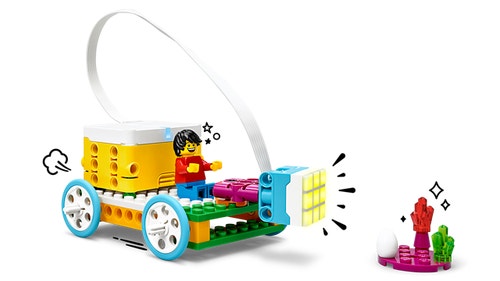Cave Car
Daniel wonders what lives inside a dark cave. What do you think is hiding in the dark?

Prepare
- Review the Cave Car lesson in the LEGO® Education SPIKE™ App.
- If you feel that it would be beneficial, pre-teach these related vocabulary words: cave, dark, light, sequence and try.
- Consider the abilities and backgrounds of all your pupils. Differentiate the lesson to make it accessible to everyone. Please refer to the Differentiation section below for suggestions on how to do this.
- If time permits, plan and facilitate the language arts extension. Please refer to the Extension section below for further information.
Engage
(Whole Class, 5 Minutes)
- Facilitate a quick discussion about helping a friend when they have a problem.
- Talk with your pupils about what they might do for a friend who needs help seeing in the dark.
- Ask questions like these: What could you do to help a friend see something in the dark? How would you describe what you are doing to help?
- Introduce your pupils to the story’s main characters and the first challenge: switching on the cave car’s light.
- Distribute a brick set and a device to each group.
Explore
(Small Groups, 30 Minutes)
- Have your pupils use the LEGO® Education SPIKE™ App to guide them through their first challenge:
- Make and try the program that switches on the cave car’s light.
- Have your pupils iterate and test their models to complete the next challenge in the app:
- Change the program for Daniel’s next trip.
- You can find help with coding in the Tips section below.
Explain
(Whole Class, 5 Minutes)
- Gather your pupils together to reflect on their completed challenges.
- Ask questions like these: What is Daniel's goal in the story? What happened to the light after you made a program for it?
Elaborate
(Whole Class, 5 Minutes)
- Prompt your pupils to discuss and reflect as they describe the process of creating a program to solve a problem.
- Ask questions like these: What did you expect would happen when you changed the program for the light? Did your light do what you had expected? How would you describe what you did to change the light?
- Have your pupils tidy up their workstations.
Evaluate
(Ongoing Throughout the Lesson)
- Ask guiding questions to encourage your pupils to ‘think aloud’ and explain their thought processes and reasoning in the decisions they have made while building and programming their models.
Observation Checklist
- Measure your pupils’ proficiency in describing a program’s sequence of events and its outcome.
- Establish a scale that suits your needs. For example:
- Requires additional support
- Can work independently
- Can teach others
Self-Assessment
Have each pupil choose the brick that they feel best represents their performance.
- Yellow: I think that I can describe a program’s sequence of events and its outcome.
- Blue: I can describe a program’s sequence of events and its outcome.
- Green: I can describe a program’s sequence of events and its outcome, and I can also help a friend to do it.
Peer Feedback
- In their small groups, have your pupils discuss their experiences working together.
- Encourage them to use statements like these:
- I liked it when you…
- I would like to hear more about how you…
Tips
Coding Tips
- After your pupils have completed their first challenge, they will be provided with a map.
- Using the map, your pupils can experiment with the available Coding Blocks to modify their programs to follow the route for the trip.




Differentiation
Simplify this lesson by:
- Reading the Cave Car story and instructions from the LEGO® Education SPIKE™ App aloud to your pupils
- Shortening the lesson to include only the first challenge
Increase the difficulty by:
- Creating a new version of the cave car
- Building what Daniel meets after he lights up the cave
Extension
- Have your pupils write an informational paragraph about the fictional creatures that live in the cave. Ask them to describe what they look like, what they eat and how they play.
If facilitated, this will extend beyond the 45-minute lesson.
Language Arts: ACELA1430
Understand that texts can take many forms, can be very short (for example an exit sign) or quite long (for example an information book or a film) and that stories and informative texts have different purposes.
Teacher Support
The pupils will:
- Describe a program’s goals, sequence of events and expected outcome
- Explore objects that can be seen if light is available
- Practise helping a story character
- Participate in collaborative conversations
(one for every two pupils)
- LEGO® Education SPIKE™ Essential Set
- Device with the LEGO® Education SPIKE™ App installed
Design and Technologies
ACTDEP005
Explore needs or opportunities for designing, and the technologies needed to realise designed solutions.
Digital Technologies
ACTDIP004
Follow, describe, and represent a sequence of steps and decisions (algorithms) needed to solve simple problems.
English Language
ACELA1430
Understand that texts can take many forms, can be very short (for example an exit sign) or quite long (for example an information book or a film) and that stories and informative texts have different purposes.




